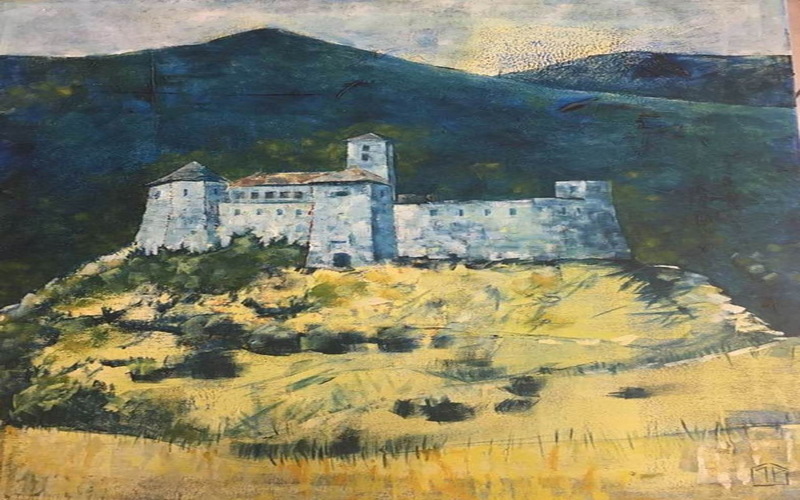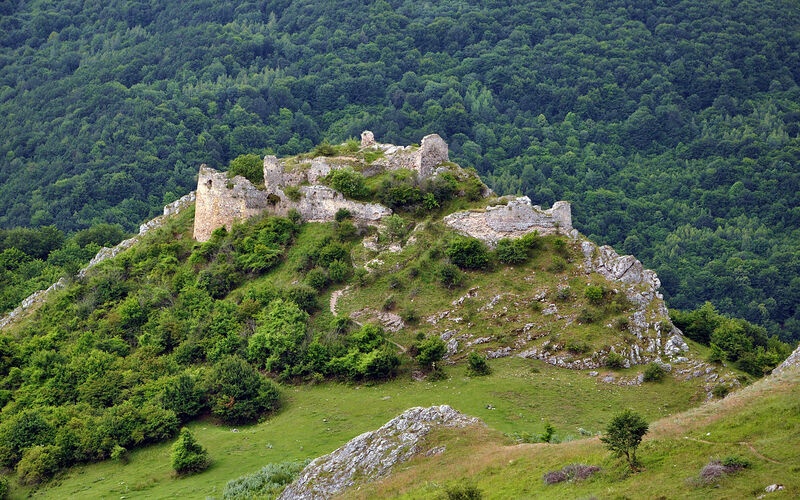


Cetatea Liteni
Liteni este situat la marginea regiunii etnografice Țara Călatei, la poalele Munților Carpați, pe ruta Cluj-Napoca–Buru. Satul se află la 30 km de Cluj-Napoca si la 36 km de Turda. Originea denumirii satului este neclară. Potrivit legendei, numele se referă la un viteaz numit Léta, dar nu există dovezi concrete în acest sens. Istoria satului este strâns legată de cea a Cetății Ghéczy, situată la 2 km de așezare. Castrum Leta era o cetate regală, și ca atare se afla sub autoritatea voievodului Transilvaniei, care răspundea de apărarea acesteia și administra tot comitatul de aici. De-a lungul veacurilor, cetatea aparținea fie comitatului Cluj, fie comitatului Turda; în acesta din urmă, căpitanii aveau titlul de vicecomite. Nu se cunoaște data construirii cetății, dar a fost fortificată împotriva atacurilor tătarilor în timpul domniei regelui Béla al III-lea, când comitatul Cluj era, pentru o perioadă, guvernat de aici. Săpăturile arheologice au scos la lumină artefacte care datează din vremuri mai vechi: rămășițe de ceramică ștanțate pe fund sau cu linii ondulate, țigle de sobă decorate cu portretul regelui Ladislau cel Sfânt și cu discul solar, vârfuri de săgeți din secolele al X-lea și al XI-lea, bucăți de unelte din piatră și inele de argint. Documentele scrise acoperă doar 200–250 de ani din istoria de 7–800 de ani a cetății. Titlurile de proprietate existente dezvăluie că regi și conducători renumiți au acordat o importanță semnificativă cetății: • Era sub autoritatea voievodului deja în timpul domniei regelui Carol Robert (1310–1342). • În 1405, regele Sigismund a donat-o orașului Cluj. • La începutul anului 1441, regele Vladislav I a dăruit-o vicevoievodului Márk Herepei. • În decembrie 1450, guvernatorul Iancu de Hunedoara i-a dat-o voievodului Transilvaniei Mihály Jakcs de Kusaly (Coșeiu) și familiei sale. Între timp, sora guvernatorului, Clara, a revendicat și ea cetatea. Drept urmare, regele Ladislau al V-lea i-a donat-o în 1456. Prin Clara și soțul ei, cetatea a devenit parte a moșiilor familiei Pongrácz de Dengeleg. Potrivit titlului de proprietate datând din acea vreme, de cetate aparțineau 15 sate, printre care și Liteni. • În 1501, regele Vladislav al II-lea a donat proprietatea lui Ioan Corvin (fiul regelui Matia). • În 1560, cetatea aparținea lui Menyhért Balassa, dar un an mai târziu, acesta s-a răzvrătit împotriva principelui Transilvaniei Ioan Sigismund, care în consecință a asediat cetatea. După revolta garnizoanei, cetatea a fost predată. Când trupele principelui au intrat, praful de pușcă ascuns în camerele subterane a explodat în circumstanțe necunoscute și cetatea s-a prăbușit, provocând moartea a 50 de soldați și a comandantului János Szilvási. • În 1562, ruinele și pământurile din împrejurimi au reintrat în posesia orașului Cluj, iar în 1569, au fost donate lui János Ghéczy (mai târziu guvernator), care a reconstruit cetatea. De aici provine denumirea Cetatea Ghéczy. După moartea guvernatorului, principele Transilvaniei Sigismund Báthory a dăruit proprietatea lui Pál Gyulai și soției sale Kata Ghéczy, precum și moștenitorilor săi. În ceea ce privește evenimentele care au urmat, nu există documente scrise. Circumstanțele celei de-a doua distrugeri a cetății, în ruine și în prezent, sunt necunoscute. Probabil a fost detonată – ca multe alte fortărețe din Ungaria – după Tratatul de la Satu Mare (1711), care a pus capăt războiului de independență al lui Rákóczi.
read more »Léta Vára
HU: Magyarléta a tágabb értelemben vett Kalotaszeg határán fekszik, a havasok alján, a Kolozsvár–Borrév útvonalon. A falu Kolozsvártól 30 kilométerre, Tordától 36 kilométerre található. Nevének eredete tisztázatlan. A legenda egy Léta nevű vitézhez köti, de erre konkrét bizonyíték nincs. A falu története szorosan összefügg a határában lévő – a falutól 2 km-re fekvő, és korábban a magyarlétai Úrbéresközönség tulajdonát képező – „Ghéczy vár” történetével. A „Castrum Léta” királyi vár volt, s mint a többi erdélyi vár az erdélyi vajda tisztsége alatt állt, aki saját embereivel őriztette és innen intézte a megye területének ügyeit. A vár hol Kolozs, hol Torda vármegyéhez tartozott, s várnagyjai Torda vármegyei alispánok is voltak. Hogy mikor épült, arról nincs feljegyzés, de minden bizonnyal III. Béla király uralkodása alatt megerősítették a korábbi várat a tatárok betörései ellen, és ebben a korszakban egy ideig innen irányították Kolozs megyét. Régészeti ásatások során felszínre kerültek régebbi emlékek is: fenékbélyegzős vagy hullámvonalas cserépedény maradványok Szent László király arcmásával és napkoronggal díszített kályhacsempék, X-XI. századi nyílhegyek, kőszerszámdarabok, ezüstgyűrűk. Írásos dokumentumok a vár 7-800 éves történetéből mindössze 200-250 évre vonatkozóan vannak, az adománylevelek alapján megállapítható, hogy nem csekély jelentőséggel bírt egyes királyok és uralkodók alatt: • Vajdai birtok volt már Károly Róbert (1310-1342) király idejében. Zsigmond király 1405-ben Kolozsvár városának adományozta. 1441 elején I. Ulászló király Herepei Márk alvajdának adományozta. Hunyadi János kormányzó 1450 decemberében kusalyi Jakcs Mihály erdélyi vajdának és családjának adta. Ugyanekkor a kormányzó Klára nevű nővére is jogot formált Léta várára, ennek eredményeként V. László király 1456-ban a várat és tartozékait neki adományozta, így általa és a férjén keresztül egy ideig a Dengelegi Pongrácz családhoz tartozott. Ebből az időből származó oklevél szerint a várhoz tartozó falvak: Léta, Szentlászló, Kisfenes, Hesdát, Barbátfalva, Asszonyfalva, Felsőfüle, Alsófüle, Egres, Hagymás, Kékbükk, Szentkirály, Mogyoróság, Sütmeg és Rákos. 1501-ben II. Ulászló király Corvin Jánosnak (Mátyás király fiának) adományozta a várat és a birtokot. 1560-ban Balassa Menyhérthez tartozott, de ő 1561-ben szembeszállt János Zsigmond fejedelemmel, aki így ostrom alá vette. Miután a várőrség fellázadt, a várat feladták. Mikor a fejedelem csapatai a várba bevonultak, a föld alatti kamrákban elrejtett lőpor felrobbant és a vár összeomlott, 50 katona Szilvási János parancsnokkal együtt a romok alá veszett. A várrom a környező birtokkal együtt 1562-ben visszakerült Kolozsvár városához, 1569-ben pedig Ghéczy Jánosnak (későbbi kormányzó) adományozták, ő állította helyre a várat. Róla nevezik Ghéczy-várnak az erősséget. Halála után Báthori Zsigmond fejedelem a birtokot Gyulai Pálnak és nejének, Ghéczy Katának és örököseinek adta. Az ezt követő eseményekről írásos dokumentumok nincsenek. A jelenleg is romokban heverő vár második lerombolásának története nem ismert. Valószínűleg a Rákóczi-szabadságharcot követő szatmári béke után (1711) robbantják fel, Magyarország sok más erősségéhez hasonlóan.
read more »Liteni Fortress
Liteni (Magyarléta in Hungarian) is situated at the edge of the broader Land of Călata (Kalotaszeg in Hungarian), at the bottom of the Carpathian Mountains, on the route between Cluj-Napoca and Buru. The village is located 30 km from Cluj-Napoca and 36 km from Turda. The origin of the village name is unclear. According to legend, it relates to a hero called Léta, but there is no concrete evidence of it. The history of the village is closely linked to that of the Ghéczy Fortress situated 2 km from the settlement. Castrum Leta used to be a royal fortress, and as such fell under the authority of the Voivode of Transylvania, who was responsible for its defence and administered the county from here. The fortress belonged alternately to Cluj and Turda castle counties. In the latter, the castellans of Castrum Leta used to have the title of vicecomes. There is no record of when the fortress was built, but it was fortified against Tatar attacks during the reign of King Béla III, when Cluj county was, for a period of time, governed from here. Archaeological excavations have brought to light artifacts dating back to earlier times: bottom-stamped and wavy-lined pottery remnants, stove tiles decorated with the portrait of King Saint Ladislaus and the sun disk, arrowheads from the 10th and 11th centuries, pieces of stone tools, and silver rings. Written documents cover merely 200–250 years of the 7–800-year history of the fortress. The surviving title deeds reveal that powerful kings and rulers attached significant importance to the fortress: • It fell under the authority of the voivode already during the reign of King Charles Robert (1310– 1342). • In 1405, King Sigismund donated it to the city of Cluj. • At the beginning of 1441, King Vladislaus I donated it to Vice-voivode Márk Herepei. • In December 1450, Governor John Hunyadi gave it to Mihály Jakcs of Kusaly (Coșeiu), Voivode of Transylvania, and his family. Meanwhile, the governor’s sister, Clara, also laid claim to the fortress. Eventually, King Ladislaus V donated it to her in 1456. Through Clara and her husband, the fortress became owned by the Pongrácz family of Dengeleg. According to the title deed dating from that time, 15 villages belonged to the fortress, including Liteni. • In 1501, King Vladislaus II donated the property to John Corvinus (son of King Matthias). • In 1560, the fortress belonged to Menyhért Balassa, but a year later, when he rebelled against John Sigismund, Prince of Transylvania, the fortress was besieged. Following the mutiny of the garrison, the fortress surrendered. When the troops of the prince entered, the gunpowder hidden in the underground chambers exploded and the fortress collapsed, causing the deaths of 50 soldiers and Commander János Szilvási. • The ruins, together with the surrounding land, were given back to the city of Cluj in 1562, and then, in 1569, donated to János Ghéczy (governor later on), who restored the fortress. That is why it is now called the Ghéczy Fortress. After his death, Sigismund Báthory, Prince of Transylvania, gave the property to Pál Gyulai and his wife Kata Ghéczy as well as his heirs. Regarding the events that followed, there are no written documents available. The circumstances of the second destruction of the fortress, currently still in ruins, are unknown. Presumably, it was detonated – similarly to several other fortresses in Hungary – after the Treaty of Szatmár (1711), which ended Rákóczi’s War of Independence.
read more »
DONEAZA!!! DONATE!!! ADOMÁNYOZZ AND HELP OUR CAUSE!!!
ASOCIATIA LETA VARA EGYESULET - Banca Transilvania: RO22BTRLRONCRT0604010501
Paypal
Contact: Czako Attila Csaba: +40740478138
Mulțumim frumos!Köszönjük szépen !Thank you very much!
